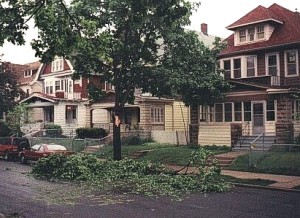Storms & the Urban Forest

Severe storms can take a toll on Tennessee’s trees. Throughout the state, trees have suffered not only wind damage but also flood damage. Severe storms have killed several trees throughout Tennessee but many of the damaged trees can survive if given the proper care. Tree owners are faced with the dilemma of trying to save or remove damaged trees.
Assessing Damage: Tree owners need to assess the damage to the tree. If there is minimal damage or if the structural integrity of the tree is still intact, despite the number of small limbs on the ground, the tree has a good chance of surviving. If there is heavy damage to the trunk or the root structure of the tree, the tree has lost a significant amount of its structural integrity and should be removed for safety reasons. Tree owners whose trees lost a large portion of their foliage should not be too hasty about removing their tree if there is not heavy structural damage. Tennessee is in the beginning of its growing season and many of the trees will be able to recover from leaf loss and re-leaf out.
Trees that have been underwater for several days need have an original assessment of the tree’s structural stability and then be watched over time to see the real affects the flood had on the tree. Trees that grow in flood prone areas have adapted to having water on their roots but it all depends on the species, the timing, and the duration of the flood as to whether they survive or not. Green ash is a species that grows in flood prone areas but is more suitable for tolerating winter floods than spring floods. Other species such as sycamore, red maple, and river birch have a higher tolerance to flooding.
Hiring a Professional: Once the damaged has been assessed, the tree can then be properly taken care of or disposed of. Tree owners working on their own trees should use extreme caution because removing trees and limbs can be extremely dangerous. If the tree cannot be removed safely or is near utility wires and structures, a professional certified arborist should be called. A certified arborist has the knowledge, training and equipment to properly remove storm-damaged trees. To find a certified arborist near you visit the International Society of Arboriculture’s web page at http://www.isa-arbor.com or look in the phonebook for arborists that are certified. Be very careful when hiring people that come to your doorstep, as many of these individuals are not properly trained and do not have insurance to cover any damage that they might cause.
Proper Pruning: Storm damaged trees should be properly pruned and not topped. A topped tree is one where the main branches of the trees are cut back to stubs. This non-professional practice is not only ugly, it causes weakly attached limbs to grow back, which are usually taller than the previous limbs. These limbs are weak and have a greater potential of falling during future storms and causing more damage. Trees need to be pruned with their natural structural mechanisms taken into considerations. Limbs need to be pruned outside the branch collar, which is the swollen or raised area where the branch and trunk of the tree connect. Proper cuts will allow the tree to heal quicker and to compartmentalize any decay that might occur. To find out more about pruning, click here. (Picture Credit: National Arbor Day Foundation).
Preventative Measures: There are several things a tree owner could do to prevent or lessen future storm damage. First, keep your tree healthy and the growth vigorous. Watering, fertilizing, and protecting trees from soil compaction are a few ways to maintain a tree's health. Tree owners should prune the dead and weakened limbs out of their trees annually and thin excess branches out of the crown to reduce the sail affect on the canopy. Also, planting the right tree will help minimize storm damage. Trees that are fast growing are usually brittle and have more of a tendency to break, endangering life and/or property.
Tree Planting: If the tree needed to be removed, a new tree should be planted in its place to provide the essential benefits. When selecting a new tree, evaluate the planting site and determine how much area the tree has to grow. Planting spaces that restrict a tree's growth because of utility lines or structures require trees with a small maturing height and crown spread, such as redbud and dogwood. Large oak trees should be planted in areas with adequate room to grow and not near structures or utility lines. To find out more about selecting a new tree, click here.